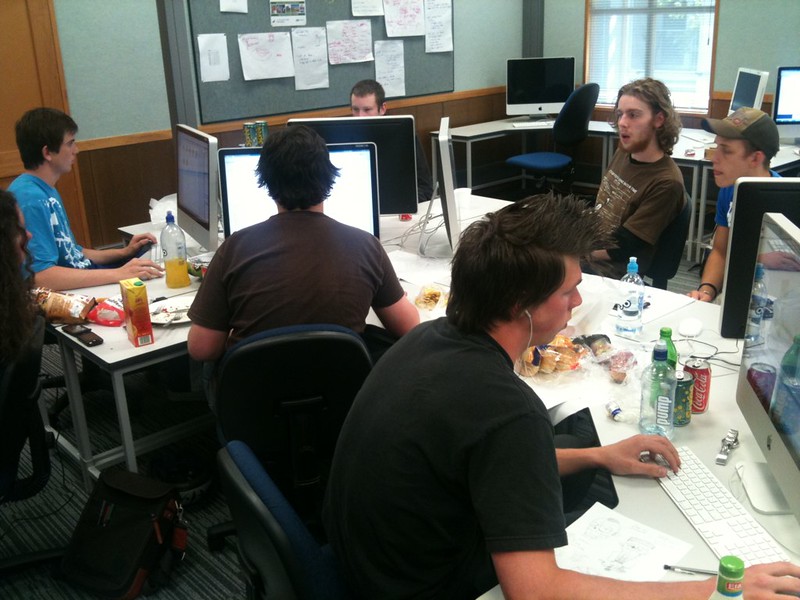- Game Jam: Global Game Jam 2010
- Theme: Deception
- Date: 2010-01-29
My second game jam was in 2010 at Otago University. This time I was teamed up with Thomas who was in 4th year with me along with George and my brother Mike who would both go on to found CloudCannon. With a theme of deception we decided to try and deceive the player. The first phase of the game would be a typical looking zombie shooter. You could walk up and down the side of the screen and fire at the zombies. It would then reset and show a normal scene with the player now controlling a new character. The shooter would replay your previous actions and you needed to remember what happened and push people out of the way.
Even though everyone was computer science students we split up between artists and coders. George handled all the background art, creating two versions of everything to distinguish the two modes. Thomas used his Blender skills to create the animated characters. I worked on the action recording and replaying and Mike handled the rest. The recording works by storing each input event with the elapsed time in a list. During the replay it checks the first item of the list until the game elapsed time has passed the items time. It then removes it and replays that action. Clearly I got confused at one point as I wrote to myself: // delta is in milliseconds, gameTime is in seconds.
The game all came together and George had time to create different news paper events for each different endings. Because the player was in charge of both halves and could replay it once they knew what was going to happen there are a few options. If it goes as we expected there are a few options for how well the player did, and even if they get hit by their previous bullets. If the shooter does nothing then there are additional endings of a paranoid player pushing people over or nothing eventful happening.

George, Tim, Thomas and David working on the game
My future brother in law David came in on Sunday to do the music. He created the same theme in two variants, with a spooky zombie theme and a happy wedding version. He also made a variation for the title screen. This music really helped show the two versions of the same event.
The final piece of the puzzle was getting all the animations in. We had temporary programmer spritesheets so we could validate that the states were working but needed all the animations from Blender. The good news was because of the skeletons, all the animations could be reused across the different characters. Unfortunately this ended up being the last step so there was a big rendering and exporting bottleneck right at the finish and we needed to make some adjustments for the final sprites. We needed to do each action from four directions for each character. In hindsight it would have been better to get one test one all the way through that could be iterated on so we could test the process before the final render, even though this would have taken more time overall.
The jam site had a great atmosphere and we got to present our games at the end. It was really interesting to see what the other teams did with the same theme as quite different games came out. It was also the first time I worked with my brother which would lead on to bigger things in the future.
Lessons Learnt
Test your pipelines early.
You can take the theme in interesting directions.